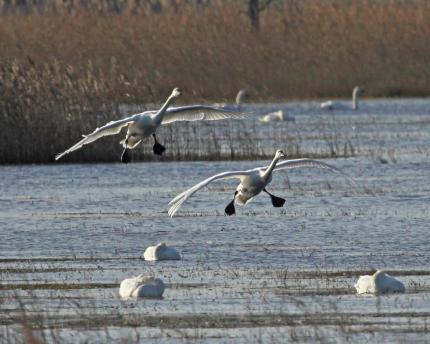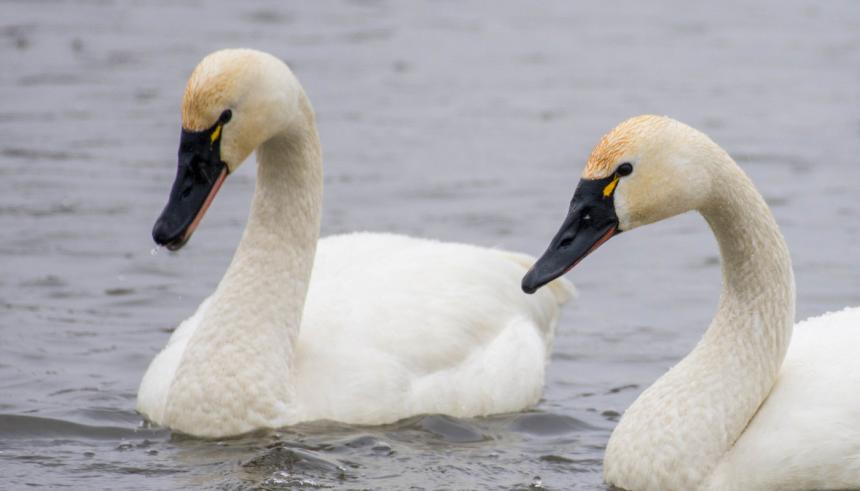Tundra swans are protected species under federal and state laws. To protect swan populations, there are no swan hunting seasons in Washington.
Description and Range
Physical description
Tundra swan are up to 59 inches in length and weigh up to 16 pounds. Adults are white; they have black bills with small yellow patches on the base of the bill. Tundra swan are noticeably smaller than trumpeter swans. For more information on how to identify tundra swan, check out the Resources section.
Ecology and life history
Tundra swans migrate to Washington for the winter from windswept tundra habitat of the Alaska Peninsula and Arctic--their breeding grounds.

Both tundra and trumpeter swans can form long-term pairs and raise their young together, with young birds following the parents during the first year to important stopover and winter areas in search of food and places to rest.
Their natural diets are made up of aquatic vegetation and underwater roots and tubers. They often eat with their heads submerged underwater. However, with changes in the availability of their native habitats, current wintering habitat is supplemented by eating grasses and leftover agricultural crops like corn and potatoes.
Swans are an example of a long-lived waterfowl species, with several individuals documented to live more than 20 years. Through the year, about five to 15 percent of swans die from natural causes, and about two percent wintering in western Washington die from hitting power lines or ingesting lead shot or fishing weights.
Geographic range
Approximately 20,000 trumpeter and tundra swans migrate between November and April. More than 1,000 trumpeter and tundra swans overwinter in Whatcom County alone. The birds arrive generally in late October and stay in northwestern Washington over the winter before beginning their northward migration in April to their breeding sites. Tundra swans breed on the Arctic and subarctic tundra, and spend their summers in Alaska, western Yukon, and northern British Columbia.
For a map of range-wide distribution and conservation status of the tundra swan, check out NatureServe Explorer.
Regulations
Rules and seasons
Trumpeter swans and tundra swans are off limits for hunting. For current rules about these swans in the state, be sure to check the Washington Game Bird and Small Game hunting regulations.
Conservation
Conservation threats
Some trumpeter and tundra swans in Washington and in southwestern British Columbia die each winter from lead poisoning after ingesting lead shot and other lead objects in areas where they feed. Lead shot has been banned for waterfowl hunting in Washington since 1991. But swans can still pick up and ingest lead shot while foraging in shallow underwater areas, in fields and roosts where lead is still present.
Swans are also vulnerable to collisions with powerlines.
Our Conservation Efforts
WDFW and other agencies and organizations have been working since 2001 to locate sources of toxic lead and minimize potential exposure through management actions.
WDFW has worked with partners, including Puget Sound Energy employees, as well as volunteers from the Northwest Swan Conservation Association, to respond to reports of sick, injured or dead birds in western Washington counties. Through this process, in 2019, the Whatcom Humane Society saved and rehabilitated four trumpeter swans - one of which was sighted again near Whitehorse, Canada 70 days after release.
To combat swan collisions with power lines, Puget Sound Energy and Snohomish County PUD have installed power line reflectors, leading to a significant reduction in deaths. Unfortunately, collisions still occur with power lines and other objects when high winds or foggy conditions cause swans to fly at lower altitude as they travel between roosts and foraging fields.
Resources
References
Hines, R.W. Ducks at a Distance: A waterfowl identification guide. Department of the Interior, U.S. Fish and wildlife Service.
